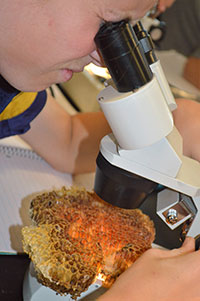A group of middle schoolers clustered around a two-sided honeybee observation hive and delivered a rapid-fire commentary on what they were seeing.
Inside the colony, thousands of bees went about their business: The queen was, presumably, laying eggs or preparing to; female worker bees attended the queen, cleaned the hive, built the honeycomb and packed pollen into cells to eat later; and male drones, well, weren’t contributing much (seriously, that’s their job).
“The window is really warm from them moving around,” said Natalie Yates as she laid her palm against the glass.
“It smells like bread baking,” said Scott Ehrlich from the other side of the 2-foot-by-4-foot structure at the back of science teacher Becky Martin’s classroom.
“Oh! That one right there is doing the waggle dance!” Natalie pointed out. “The dance is telling them which direction something is.”
“Every point-eight seconds (of the dance) means 100 meters away,” Hania Timek told a visitor.
“And they can go like three miles away and find their way back,” Scott added.
Graham Sterling, who described himself and Natalie as “both big bee nerds,” knelt so he could see the action in the bottom frame. “They’re festooning here,” he said, pointing with his pen. “It’s a form of communication where they hold onto each other’s legs.”

Creating a Buzz
The seemingly endless buzz around the indoor bee hives is music to Martin’s ears. She and fellow science teachers Lindsey Lantz and John Burke were awarded a $6,112 grant from the East Grand Rapids Schools Foundation to have honeybee observation hives installed in their classrooms.
Martin, who already had been keeping bees at home for about a year, was awarded a WIlliam O. VandenBerg Scholarship from the district to earn Master Beekeeping Certification at Cornell University.
Frames were taken from Martin’s own hives in the spring, and the trio of teachers suited up in protective gear and installed them before school resumed this year. Bees fly in and out via an access hole to the outdoors that is inaccessible to students.
“I thought this kind of real-world study would mesh perfectly with our science curriculum,” Martin said.
All middle school science classes will use the observation hives throughout the school year: when studying cells and microorganisms, plants and pollination, populations and pollution, to name just a handful.
“This transcends math and science,” she added. “It connects them with nature in a way that is so beyond the norm in our culture. I see it also as a way to teach about social responsibility, to understand that honeybees play such a huge role in our lives.”
Admitted Robbie Dwortz, “I was scared at first” to share a classroom with a beehive. “Turns out I was only scared of one kind of bee, which we don’t have in there.”
Martin pointed out that honeybees are “actually very gentle.”
“You just kind of have to get over the idea of it.”
CONNECT
SNN article: Buzzing with Curiosity, Students Learn About Bees












